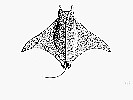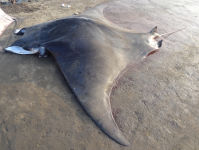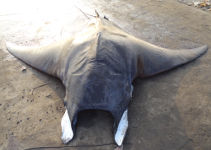Mobula tarapacana
(Philippi, 1892)
Chilean devil ray
Classification: Elasmobranchii Myliobatiformes Mobulidae
Reference of the original description
Algunos peces de Chile. Las rayas, Callorrhynchus i Orthagoriscus Chilenos. Anales del Museo Nacional de Chile. Primera seccion, Zoología, 3, 1–17
Algunos peces de Chile. Las rayas, Callorrhynchus i Orthagoriscus Chilenos. Anales del Museo Nacional de Chile. Primera seccion, Zoología, 3, 1–17
Image of the original description
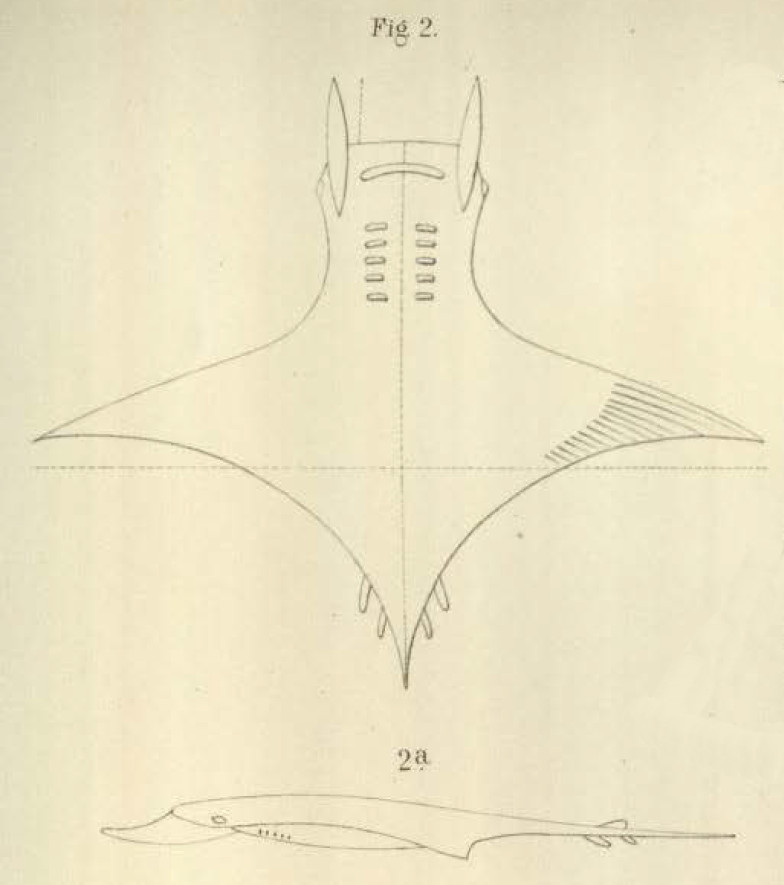
Cephaloptera tarapacana Philippi, 1892, Pl. III, Fig. 2

Cephaloptera tarapacana Philippi, 1892, Pl. III, Fig. 2
Synonyms / new combinations and misspellings
Cephaloptera tarapacana, Mobula cf. tarapacana, Mobula coilloti, Mobula formosana, Mobula tarapanaca
Cephaloptera tarapacana, Mobula cf. tarapacana, Mobula coilloti, Mobula formosana, Mobula tarapanaca
Types
Mobula tarapacana
Holotype: XXXX: No types known;
Mobula coilloti
Holotype: MNHN: 1965-0144;
Mobula formosana
Holotype: TFRI: 2911;
Mobula tarapacana
Holotype: XXXX: No types known;
Mobula coilloti
Holotype: MNHN: 1965-0144;
Mobula formosana
Holotype: TFRI: 2911;
Description :
Citation: Mobula tarapacana (Philippi, 1892): In: Database of modern sharks, rays and chimaeras, www.shark-references.com, World Wide Web electronic publication, Version 04/2024
Please send your images of "Mobula tarapacana" to info@shark-references.com
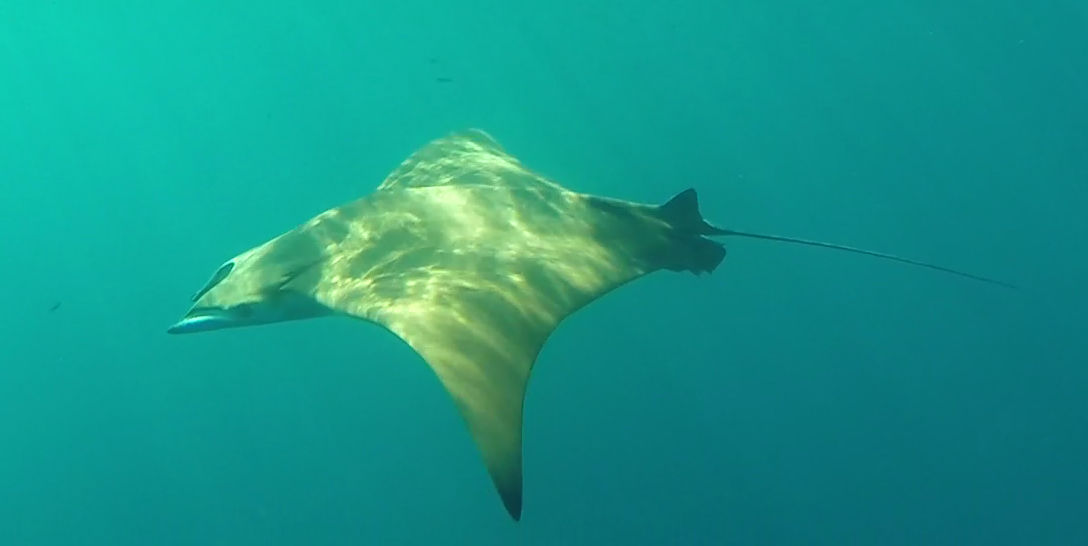
Mobula tarapacana (Philippi, 1892), 3 m disc width, male, 12 Mile Reef, Bermagui, New South Wales, Australia, © Anton Vogiatzis, Australia

Mobula tarapacana (Philippi, 1892), 3 m disc width, male, 12 Mile Reef, Bermagui, New South Wales, Australia, © Anton Vogiatzis, Australia
Common names
 Diablo gigante de Guinea,
Diablo gigante de Guinea,  Manta cornuada,
Manta cornuada,  Manta cornuda,
Manta cornuda,  Raya cornuda,
Raya cornuda,  Diable géant de Guinée,
Diable géant de Guinée,  Mante chilienne,
Mante chilienne,  Chilean devil ray,
Chilean devil ray,  Devil ray,
Devil ray,  Greater Guinean mobula,
Greater Guinean mobula,  Sicklefin devil ray,
Sicklefin devil ray,  Spiny mobula
Spiny mobula
 Diablo gigante de Guinea,
Diablo gigante de Guinea,  Manta cornuada,
Manta cornuada,  Manta cornuda,
Manta cornuda,  Raya cornuda,
Raya cornuda,  Diable géant de Guinée,
Diable géant de Guinée,  Mante chilienne,
Mante chilienne,  Chilean devil ray,
Chilean devil ray,  Devil ray,
Devil ray,  Greater Guinean mobula,
Greater Guinean mobula,  Sicklefin devil ray,
Sicklefin devil ray,  Spiny mobula
Spiny mobula
Short Description
A large devil ray with a long head bearing short head fins; dorsal fin plain, and pectoral fins with strongly curved, swept-back tips; upper disc densely covered with small, pointed denticles and tail shorter than disc with no spine [536]. Dark blue [536], olive-green to brownish above; ventral side white anteriorly, grey posteriorly, with an irregular but distinct line of demarcation [20053]. No caudal fin [536].
A large devil ray with a long head bearing short head fins; dorsal fin plain, and pectoral fins with strongly curved, swept-back tips; upper disc densely covered with small, pointed denticles and tail shorter than disc with no spine [536]. Dark blue [536], olive-green to brownish above; ventral side white anteriorly, grey posteriorly, with an irregular but distinct line of demarcation [20053]. No caudal fin [536].
Distribution
Circumtropical, recorded from scattered localities. Western Atlantic: off Venezuela. Eastern Atlantic: Côte d"quot; Ivoire and South Africa. Reported from Cape Verde [20238]. Western Indian Ocean: northwestern Red Sea. Western Pacific: Japan, Taiwan, and probably tropical Australia. Eastern Pacific: Gulf of California and Chile.
first record: 12 Mile Reef, Bermagui, New South Wales, Australia [24209];
Circumtropical, recorded from scattered localities. Western Atlantic: off Venezuela. Eastern Atlantic: Côte d"quot; Ivoire and South Africa. Reported from Cape Verde [20238]. Western Indian Ocean: northwestern Red Sea. Western Pacific: Japan, Taiwan, and probably tropical Australia. Eastern Pacific: Gulf of California and Chile.
first record: 12 Mile Reef, Bermagui, New South Wales, Australia [24209];
Human uses
fisheries: subsistence fisheries
fisheries: subsistence fisheries
Biology
Exhibit ovoviparity (aplacental viviparity), with embryos feeding initially on yolk, then receiving additional nourishment from the mother by indirect absorption of uterine fluid enriched with mucus, fat or protein through specialised structures [733]. Mostly oceanic, but also in coastal waters. Solitary, sometimes forms groups [1658]. Feeds on small fishes [536] and planktonic crustaceans (Ref. 9911).
Exhibit ovoviparity (aplacental viviparity), with embryos feeding initially on yolk, then receiving additional nourishment from the mother by indirect absorption of uterine fluid enriched with mucus, fat or protein through specialised structures [733]. Mostly oceanic, but also in coastal waters. Solitary, sometimes forms groups [1658]. Feeds on small fishes [536] and planktonic crustaceans (Ref. 9911).
Size / Weight / Age
328 cm WD (male/unsexed; [2539]); 305.2 cm WD (female); max. published weight: 350.0 kg (Ref. 50641)
328 cm WD (male/unsexed; [2539]); 305.2 cm WD (female); max. published weight: 350.0 kg (Ref. 50641)
Remarks
shark-references Species-ID=3765; CITES: (see: Protected Species for more details) Convention on International Trade in Endangered Speciesof Wild Fauna and Flora annex: II; Council Regulation 2017/160 annex: B
shark-references Species-ID=3765; CITES: (see: Protected Species for more details) Convention on International Trade in Endangered Speciesof Wild Fauna and Flora annex: II; Council Regulation 2017/160 annex: B
Parasites (arranged by Jürgen Pollerspöck)
Copepoda
Isopoda
Copepoda
Isopoda
- Gnathia trimaculata Coetzee, Smit, Grutter & Davies, 2009 [17188]








